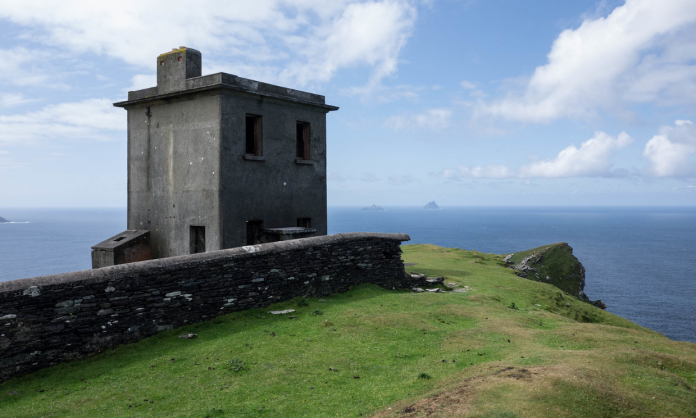By Brian McLaughlin
The failed French expedition in 1796 – 1797 was an attempt by the Republic Of France to help the United Irishmen in their planned rebellion against British rule. As a result of that episode the British embarked on a project of building martello towers all along the Irish coast to be used as signal towers for any unwanted encroachment of Irish shores.
On the Western end of Valentia Island in county Kerry is Bray Head and at its summit is Bray Tower a two-storey abandoned signal tower built by the British in 1815 during the Napoleonic Wars. It has the design of a 16th century Irish tower house with a chimney and surrounded by a stone wall.
The Bray Head tower was used by the British navy in 1907 as a signal station and it was briefly reoccupied by the Irish coast watchers during ‘The Emergency’ in World War II. It was the coast watchers who set stones in the turf below the tower to spell out ÉIRE to advise aircraft that they were passing over neutral territory. A similar inscription with stones is in place at Ballyhillion Tower in Malin Head in Inishowen in Donegal where scenes of Star Wars were shot.
The old signal tower in Valentia was built on the edge of cliffs and has stunning views over the Skellig Islands, the cliffs of Dingle and the Iveragh peninsula. There is a ninety minute loop walk to the tower from a new car park. Today there are plans to conserve the Island’s signal tower with Kerry County Council now seeking planning permission to redevelop the site from An Bord Pleanála.
The proposed works involve a stabilising and conserving the existing signal tower building and removing non-original extensions, roof and chimney. The plans also include installing a new concrete spiral staircase, viewing platform at roof level and WiFi antennae along with a viewing point at ground level with a telescope. It is also proposed to rebuild the tower site boundary wall in its original footprint using Valentia slate.
Valentia Island in South-West Kerry was an Eastern terminus for the first commercially viable transatlantic telegraph cable to Newfoundland in Canada in 1866. It operated for one hundred years and ended when Western Union terminated its cable operations in 1966. A memorial today marks the laying of the cable.
Valentia is well-known to sea-goers as it is one of only three coastguard marine rescue communications stations in Ireland along with Malin Head and Dublin and it is a referenced location used during weather forecasts. The Island lighthouse was built on the site of a 17th century fort at Cromwell Point and a lighthouse keeper lived on site until 1947 when the lighthouse was automated.
Literature on the lighthouse claims that the fossilised footprints of a dinosaur are visible from the lighthouse. It is believed that a Tetrapod which is a four-legged animal with a backbone stepped from water onto the land there over three hundred million years ago.








